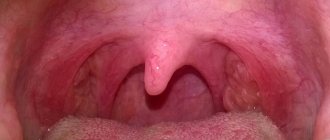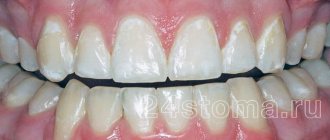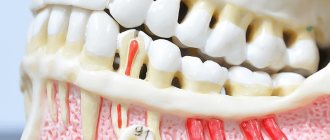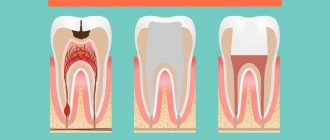Toothache always comes at the wrong time. It interferes with restful sleep, prevents you from concentrating, and pesters you at the most inopportune moments.
To get rid of unpleasant whining, terrible twitching and a growing wave of unpleasant sensations, it is enough to make an appointment with the dentists of the Nurimed clinic and undergo treatment.
If it is not possible to consult a dentist, follow the following recommendations. They will help alleviate the situation and temporarily relieve discomfort.
Causes of inflammation
As a rule, inflammation of the root part of the teeth is provoked by two factors - infection and trauma to the jaw and dental units.
In turn, the development of infections leads to:
- Untimely elimination of advanced caries.
- Incorrect treatment of pulpitis.
- A poorly made and then installed crown, under which food debris penetrates. When they decompose, they lead to the growth and reproduction of bacteria.
- Injuries to the gums due to an incorrectly installed crown or prosthesis. More often, these areas are visible as bleeding, scarlet-red, and swollen.
- Frequent diseases of bacterial sore throat.
- Chronic sinusitis, provoking the growth and reproduction of pathogenic flora.
In all of these cases, the root also becomes inflamed, since pathological processes are transferred to it.
As for injuries, as causes of pathology, these are:
- An incorrectly filled tooth, on which the load increases when chewing.
- Fractures that occur after injuries to the jaw, incorrectly installed crowns.
- Increased tooth mobility that occurs due to injuries to the nerves or vessels of the root canal.
- Excessively high crown restored from composite materials.
- The use of “old” antiseptics to treat canals that are inflamed (we are talking about arsenic).
Regardless of the cause of the development of the inflammatory root process, the patient experiences obvious discomfort and constant pain.
Methods for treating exposed roots
Diagnostics and a thorough study of the pathogenesis make it possible to determine the method of treating the disease. The degree of pathology in periodontitis and other diseases that have led to tooth exposure can be determined by X-ray examination. Depending on the identified cause and degree of receding gum level, a specialist may recommend surgical or non-surgical treatment methods.
If surgery is not necessary:
- supragingival and subgingival calculus are removed;
- professional systems for cleaning the neck and roots of teeth are used;
- appropriate dental restoration is performed;
- if necessary (for periodontitis), splinting of mobile groups of teeth is carried out;
- correction of malocclusion is carried out;
- a course of therapeutic procedures is carried out aimed at restoring natural metabolic processes in the gum tissue.
- If surgical intervention is necessary, the doctor performs a flap operation to replace the required volume of gingival tissue in order to restore the aesthetics of its edge.
Symptoms, signs of the disease
Inflammation of tooth roots can be acute or chronic. The first variant of pathology is more pronounced. Here the unfavorable symptoms look like this:
- Almost constant aching pain in the affected area. Pain syndrome manifests itself regardless of the time of day. It intensifies if the affected area is impacted (cleaning, chewing, touching).
- Sensation of tooth enlargement. The patient feels the jaw not closing tightly.
- Enlarged lymph nodes under the jaw from the side of the inflamed part of the dental unit.
- Throbbing pain, accompanied by chills and increased body temperature.
- Pain transmitted to the trigeminal nerve.
Acute processes are often accompanied by the accumulation of pus in the affected area. Here the doctor faces the main task - removing secretions, eliminating the painful focus, and channel therapy according to modern protocols.
Signs of chronic pathology are:
- Pain occurs when pressing on the crown or chewing. If the tooth is not touched, it will not be painful.
- Bad breath.
- Formation of a fistula and exit of exudate through it. This symptom is especially characteristic of granulating periodontitis. This zone is often visible as a section of gum that has changed in color and appearance.
Chronic inflammation is often treated conservatively. Only in the most difficult situations is surgical intervention indicated - removal of the root tip or the entire unit at once.
How does tooth inflammation manifest?
The first signs of acute inflammation are:
- Redness of the gums around the tooth.
- Swelling.
- Pain when biting, pressing, and later without it.
- Sensitivity to temperature changes, sour, sweet.
- Enlargement of regional lymph nodes.
- Bleeding gums.
If the inflammation has progressed to a chronic stage, the patient may observe:
- Increase in temperature (local or general).
- Weakness.
- Intense pain.
- Inflammation is manifested in the results of clinical tests.
PROMOTION
Hygienic teeth cleaning
2000 rub.
Professional treatment of the inflammatory process
If any of the symptoms of inflammation in the roots occur, you should immediately contact your dentist. Depending on the clinical picture, the doctor selects one of the treatment tactics:
- Conservative help. It involves eliminating the cause of the inflammatory process, cleaning the canals, re-treating them, disinfecting the affected area, filling the canals, installing new temporary fillings with anti-inflammatory drugs. After complete neutralization of the inflammatory process, the doctor restores the anatomy of the unit with composite material or a crown. With conservative treatment, the patient must be prescribed a course of antibiotics. The drugs neutralize inflammation well. The doctor selects the type of drug therapy for internal administration and rinsing according to the age, as well as the medical indications of the patient.
- Surgical intervention (surgical therapy). It all depends on the area of root damage. The doctor decides to remove 1/3 of its area (apex), ½ part or the entire unit plus the dental alveoli. Today, modern dentistry practices maximum tooth preservation. In approximately 80-90% of cases, a diseased tooth can be saved and treated using a conservative method using properly selected antibiotics and without even removing the top of the root.
Is it possible to do without going to the dentist?
A visit to the dental clinic is the only way to get rid of inflammation and, if possible, save the tooth. The sooner the drugs are taken, the higher the likelihood of a favorable outcome. Otherwise, the patient risks getting the complications described above, among which tooth loss is not the most unpleasant outcome.
Timely detection of the disease is the key to success. Don't rely on home treatment. Without the intervention of a dentist, tooth inflammation can only progress, causing more and more dangerous consequences over time.
Treatment at home
In case of inflammation of tooth roots, home remedies or your own efforts are not enough. Since the process occurs hidden, only a doctor can determine the intensity of the lesion and later select treatment tactics. Self-administration of any antibiotics, anti-inflammatory drugs, and even more so the use of traditional therapy is strictly prohibited. Ignoring the problem and trying to treat root inflammation at home can lead to the formation of a purulent cyst, its further rupture and, as a result, sepsis.
It is worth considering that the roots of the teeth are located as close as possible to the brain. Therefore, any infection, pus, or serous contents that enter the bloodstream here quickly reach the brain vessels. No folk remedies (compresses, rinses) used at home will help here.
The only acceptable drug for home use is a local analgesic. To eliminate pain, you can take medications such as Ketanov, Ketalong, Analgin. After this, you should consult a doctor as soon as possible.
Causes of tooth sensitivity
To understand how to reduce tooth sensitivity, you need to understand the causes of pain and remove irritating factors.
Dentists identify systemic and non-systemic causes of hyperesthesia. For example:
- Improper oral care. This includes brushes with hard bristles and overuse of teeth whitening. These factors thin the enamel, which contributes to the development of the disease.
- Mechanical damage. Any chips and cracks expose nerve endings. As a result, the sensitivity of tooth enamel to external irritants increases. To avoid problems, dentists do not recommend constantly gnawing seeds, opening hard packaging with your teeth, biting wire, etc.
- Genetic predisposition. In some people, increased wear of tooth enamel is genetic. To avoid complications, you need to visit the dental office regularly.
Systemic factors include changes in the body and diseases in which increased tooth sensitivity is a side effect:
- Viral diseases;
- Infections;
- Pregnancy;
- Hormonal disbalance;
- Pathologies of the digestive tract;
- Lack of minerals and vitamins.
Aimed Center - professional dental care
All types of dental services are provided by the Aimed clinic for residents of Moscow, Northern, Southern Butovo. The center employs doctors with many years of experience. Specialists provide therapeutic, surgical, endodontic, orthopedic, orthodontic treatment according to new European protocols. When treating tooth root inflammation and providing other services, we guarantee our patients:
- Complete painlessness of the procedure, use of proven, certified anesthetics;
- A comfortable clinic environment that is incomparable to hospital conditions;
- Use of new Japanese, American, European equipment for accurate diagnosis and treatment;
- Use of modern consumables, drugs from Israel, USA, Japan;
- Possibility of visiting the center from 08:00 to 21:00, seven days a week, holidays;
- Reception of patients of any age from the youngest to the elderly;
- Formation of favorable prices for all services without compromising the quality of the work performed.
- To make an appointment with a specialist, call +7 (495) 120-66-43. Clinic operators select a convenient time for your visit. And in the clinic’s parking lot there is always a free space for your car. We located at the metro station st. Gorchakova.
Remember, you should never ignore toothache. A minute of delay or self-therapy with folk remedies (rinses, compresses) threatens with serious complications!
Why do the roots of teeth become inflamed?
- As a consequence of advanced untreated caries or pulpitis. In this case, we are talking about infectious periodontitis, in which inflammation gradually spreads to the periodontium and rapidly progresses. In some cases, the cause of apical periodontitis may be complications of sinusitis or osteomyelitis (the so-called extradental form).
- When injured. The development of traumatic periodontitis can be provoked not only by heavy objects hitting the face or a strong blow to the jaw during a fall, but even minor, but constantly recurring microtraumas. As a rule, traumatic periodontitis is particularly acute.
- Improper treatment of pulpitis can also lead to inflammation of the tooth root - drug-induced periodontitis. The inflammatory process develops as a result of the contact of drugs containing arsenic or other potent chemical compounds on the surface of the periodontium. Sometimes the root becomes inflamed as a result of an acute allergic reaction to certain medications used in the conservative treatment of pulpitis.
Other factors leading to periodontitis
- Obstruction of root canals.
- Perforation of the root wall or cavity.
- The appearance of cysts, which can be located around the very root of the tooth or grow into the maxillary sinuses.
- Damage to the root during the removal of the stump or pin.
In some cases, we are not talking about apical, but about the so-called marginal periodontitis, in which not only the apex of the tooth root is affected, but also the gums in its cervical part. The treatment of such severe pathology should be carried out by a specialized periodontist.
Signs of weakened teeth and gums
- The gums began to bleed.
- Teeth react painfully to cold or hot.
- Small pieces break off from the tooth enamel.
- Dark spots appeared on the tooth surface, and the enamel itself began to turn yellow.
- My mouth began to smell unpleasant.
- Redness and swelling occasionally appear on the gums.
If you find at least one of the listed signs, visit your dentist as soon as possible. At an early stage, teeth can be strengthened and gums treated using special means and procedures.
Weak and loose gums: causes
To understand how to strengthen your gums at home, it is important to understand the causes of gum inflammation. If you look carefully at the photos of patients with gingivitis and periodontitis (Fig. 1-6), you will see that in absolutely all photographs in the area of the necks of the teeth or in the interdental spaces you can see accumulations of soft microbial plaque and/or deposits of hard tartar . And this is no coincidence. Inflammation in the gums does not occur on its own - it occurs solely due to the impact of pathogenic bacteria on the gums by microbial plaque and tartar.
Bacteria release various toxins and pathogens, which trigger an inflammatory reaction in the gums. And when you start using various mouth rinses, gum ointments or pastes for bleeding without removing plaque, all this does not in any way affect the cause of inflammation (plaque and tartar), but only allows you to muffle its symptoms. Due to strong active components, swelling and redness of the gums and bleeding are temporarily reduced. At the same time, pathogenic bacteria remaining on the teeth will continue to produce toxins, slowly and less noticeably continuing to destroy the gums.
Important: any antiseptic or anti-inflammatory agents for gums, used without first removing dental plaque, lead only to a temporary reduction in the symptoms of inflammation, but most importantly, to the transition of inflammation into a chronic form and unnoticed progression of the disease.
It is logical that the appearance of dental plaque is associated with insufficient/irregular oral hygiene. But when you start talking about this with patients, almost no one wants not only to admit this fact, but also to change their behavior pattern (dental care). Good oral hygiene includes more than just brushing your teeth after every meal, i.e. 3 times a day, but also be sure to use dental floss to clean the interdental spaces. Therefore, it is very important, among other things, to avoid snacking between meals.
Over the many years of working as a periodontist, I have seen thousands of patients who were willing to spend a lot of time preparing various tinctures, gum massage, all kinds of rinses and applications. But when it came to brushing their teeth, they were not able to spend 5 minutes 3 times a day to properly brush their teeth, first with floss, and then with a toothbrush and toothpaste. Although, it is this, and not various medications, that is the key to healthy teeth and gums.
Yes, and one more important point - looking in the mirror at their inflamed gums, some patients may not see the accumulation of plaque and tartar. How so? - you ask. Not only did they tell me that stones on the teeth are formed not from hard water, but from poor hygiene... there are also no stones on the teeth, but there is inflammation in the gums. What's the matter, doctor? I believed you so much... and then comes a crying emoticon. But the whole point is that hard dental deposits can be not only supragingival, but also subgingival.
In patients with chronic periodontitis, hard dental deposits (tartar) most often form in periodontal pockets, and look like microbial plaques of different sizes, firmly attached to the surface of the tooth root. Such subgingival dental plaque causes even more damage to the gums than supragingival plaque. At the same time, finding and removing them, due to the lack of visual control, is much more difficult and requires a certain skill and perseverance.
In the photo below you can see how teeth with periodontitis that appear to have completely normal gums can actually have a deep periodontal pocket with a large amount of destroyed bone tissue (the second photo was taken after gum detachment). And this destruction was caused by the very subgingival tartar that we indicated with the arrow.
This bone destruction caused by subgingival dental plaque proceeds unnoticed until a certain point - until the amount of bone destruction becomes so large that tooth mobility occurs. In general, after this, all treatment comes down to the fight for survival and an attempt to delay tooth extraction. Therefore, you need to go to the dentist and remove deposits - not when it gets really bad, but much earlier.
Paste for strengthening teeth
Along with universal pastes for caries prevention, manufacturers offer special products that restore the pH balance of the oral cavity and prevent the formation of tartar. There are toothpastes to strengthen tooth enamel. They are low abrasive due to ultra-fine particles and contain natural strengthening components. For example, theobromine, isolated from cocoa beans, is added to Theodent Classic paste; it reduces tooth sensitivity and restores enamel strength.
Many products for strengthening tooth enamel also have a mild whitening effect. For example, the Japanese Apagard M-Plus paste delicately whitens and restores enamel, and its composition is suitable even for pregnant women. Such pastes for strengthening teeth remove the very cause of their darkening - soft plaque.
Please note that the dentist must select the paste. This is especially true for teeth strengthening products with whitening and fluoridation effects. Prescribing such a remedy to yourself can cause harm.
Elimination of toothache due to caries
Caries is the most common dental disease. It begins with a barely visible dark spot on the enamel, the affected area subsequently grows, and gradually destroys the entire tooth. You can quickly relieve toothache caused by caries using folk remedies, but the disease itself can only be treated by filling it in a dental office.
You can understand that toothache is caused by caries by examining the sore spot with a mirror. If there are dark or light spots on the enamel, the likelihood of caries is very high. The pain is characterized by a short duration of attacks, clear localization, and sensitivity to temperature changes. Pain may occur when eating sweet, salty or sour foods.
The best methods of pain relief for caries:
- Camphor alcohol. It should be applied liberally to a small piece of cotton swab, which is applied to the diseased tooth for an hour and a half. The gums near the affected area are lightly lubricated with camphor alcohol; you cannot leave a swab soaked in it on the gums, as the substance can cause a burn.
- Novocaine rinse. Two hundred milliliters of 10 percent novocaine are mixed with beaten white of a fresh egg and a teaspoon of extra salt. Rinse your mouth for 5–7 minutes. The remedy is especially effective if the tooth hurts under a filling.
- Unrefined vegetable oil. To quickly relieve pain, roll a tablespoon of vegetable oil at room temperature in your mouth for ten minutes.










